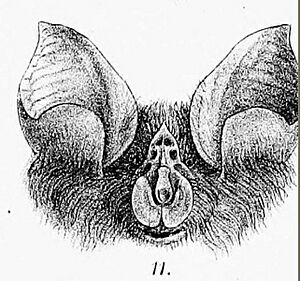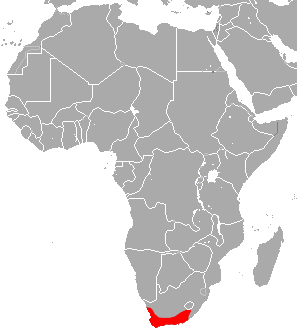Cape horseshoe bat facts for kids
Quick facts for kids Cape horseshoe bat |
|
|---|---|
 |
|
| Conservation status | |
| Scientific classification | |
| Genus: |
Rhinolophus
|
| Species: |
capensis
|
 |
|
| Cape horseshoe bat range | |
The Cape horseshoe bat (Rhinolophus capensis) is a special kind of bat. It belongs to the Rhinolophidae family. This bat is only found in South Africa. Its home might be at risk from habitat loss and people bothering its roosting spots. Even so, there are enough of them for the IUCN to consider them of least concern. This means they are not currently in danger of disappearing.
The Cape horseshoe bat is part of a group called the Rhinolophus capensis species group. Other bats in this group include the Bushveld, Dent's, and Swinny's horseshoe bats. The Cape horseshoe bat itself is unique, meaning it doesn't have different types or subspecies.
Contents
What Does the Cape Horseshoe Bat Look Like?
The Cape horseshoe bat is a medium-sized bat for its family. Its head and body are about 5.8 to 6.2 centimeters (2.3 to 2.4 inches) long. Its tail measures about 2.4 to 3.2 centimeters (0.9 to 1.3 inches). These bats usually weigh between 10 and 16 grams (0.35 to 0.56 ounces).
Fur and Ears
Most of their fur is dark or pale brown. Their belly is lighter, often a fawn-grey color. They have large, somewhat rounded ears. These ears can move on their own, which helps them hear better.
Unique Nose-Leaf
One special feature is their nose-leaf. It looks like a horseshoe and doesn't reach the top of their snout. A rounded, slightly hairy part runs from the middle of the nose-leaf. This connects to a spear-shaped part above and between their eyes. This unique nose helps them with echolocation.
How They Fly
Their wings are designed for slow, but very agile, flight. This means they can fly slowly and turn quickly in the air. This skill allows them to hunt well among thick plants and trees.
Where Do Cape Horseshoe Bats Live?
Cape horseshoe bats live only in the Cape Province of South Africa. They prefer to live in shrubby areas along the coast.
Daily Life and Roosting
These bats are nocturnal, meaning they are active at night. During the day, they rest in large groups. They often choose coastal caves or old mine tunnels as their roosting spots. You might find them sharing these spots with other bat species. These can include Geoffroy's horseshoe bat and Schreibers' long-fingered bat.
What Do They Eat?
Cape horseshoe bats are ambush hunters. They hide among plants and wait for their prey. They mainly eat beetles and moths.
How They Use Echolocation
They use echolocation to find their food. This means they send out sound waves and listen for the echoes. Their calls are quite long, lasting from 28 to 42 milliseconds. There are only short breaks between each sound pulse. The highest sound frequency they use varies from 82 to 86 kHz among different bats. This type of call helps them quickly find fast-moving insects, even in places with lots of plants.
Cape Horseshoe Bat Family Life
The breeding season for Cape horseshoe bats happens from August to September. This is shortly after they wake up from their winter sleep.
Baby Bats
After about three or four months of pregnancy, the mother bat gives birth to one baby. This usually happens in November or December. This timing is perfect because it's just before the rainy season. During the rainy season, there are lots of insects for the new mother and baby to eat. The young bats are ready to stop drinking milk by the end of January. They become old enough to have their own babies in their second year.


